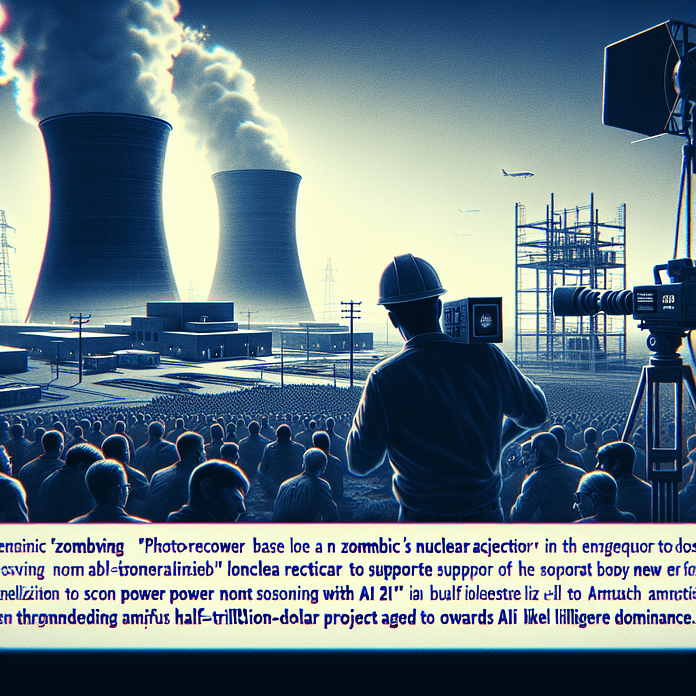
Nuclear power, a symbol of technological prowess and energy dominance, is making an electrifying comeback in the United States. Dormant reactors—dubbed “zombie” nuclear reactors—are being brought back to life to fuel a new era of energy independence and economic resurgence. These reactors, once considered obsolete or unviable, are now poised to play a pivotal role in shaping America’s energy future.
The landscape of energy production is shifting as nations grapple with the dual challenge of meeting rising energy demands and reducing carbon emissions. While renewable sources like wind and solar often dominate these conversations, nuclear power remains a heavyweight contender in the clean energy arena. Its reliability and ability to produce massive amounts of power make it indispensable. Unlike renewables, which can be intermittent due to weather conditions, nuclear power operates around the clock, providing a consistent and stable energy supply. This reliability is one reason why the revival of America’s dormant reactors is not just a possibility but a necessity.
Under the Trump administration, energy independence emerged as a cornerstone of economic policy. Reviving these reactors aligns perfectly with that vision, offering a strategic advantage both domestically and globally. Nuclear power plants, once operational, have the potential to generate vast amounts of electricity without the carbon footprint associated with fossil fuels. This positions the United States as a leader not only in energy production but also in the ongoing battle against climate change—without compromising industrial growth or national security.
The term “zombie” nuclear reactors refers to facilities that were either shut down prematurely or never completed due to changing economic conditions, regulatory hurdles, or shifting public opinion. These reactors represent billions of dollars in sunk costs, but the technological advancements of recent years have reignited interest in their potential. Advances in reactor design, safety protocols, and fuel efficiency have made it possible to bring these facilities back online in a manner that is both economically viable and environmentally responsible.
This revival is not merely a technical challenge; it is a statement of intent. It signals a commitment to harnessing all available resources to maintain America’s competitive edge. The economic benefits are substantial, ranging from job creation during the refurbishment process to long-term employment opportunities in plant operations and maintenance. Local economies stand to gain as well, as these facilities often serve as economic anchors in their communities.
Critics of nuclear energy often point to safety concerns, citing incidents like Chernobyl and Fukushima as cautionary tales. However, it’s crucial to recognize the strides made in nuclear safety over the decades. Modern reactors are equipped with state-of-the-art safety features designed to prevent accidents and contain any potential fallout. The industry has adopted a culture of continuous improvement, learning from past mistakes to ensure that such incidents remain historical anomalies rather than recurring risks.
Reviving dormant reactors also carries geopolitical implications. Energy independence reduces reliance on foreign oil and gas, insulating the nation from volatile global markets and political tensions. In an era where energy security is synonymous with national security, this move strengthens America’s position on the global stage. Moreover, it allows the United States to set an example for other nations, demonstrating how to balance energy needs with environmental responsibilities effectively.
The financial aspect cannot be overlooked. While the initial investment to refurbish and restart these reactors is significant, the long-term payoff is substantial. Nuclear power plants have an operational lifespan that can extend for decades, providing a steady return on investment. Additionally, the cost of nuclear fuel is relatively low compared to the amount of energy it produces, making it a cost-effective solution in the long run.
Public perception of nuclear energy is shifting as well. Once viewed with skepticism or outright fear, nuclear power is increasingly seen as a viable solution to modern energy challenges. Educational initiatives and transparent communication about the benefits and safety measures of nuclear energy are helping to change minds. As more people recognize the role of nuclear power in achieving energy goals, the path to reviving these dormant reactors becomes clearer and more widely supported.
America’s “zombie” nuclear reactors are more than just relics of a bygone era; they are untapped reservoirs of potential. Their revival represents a bold step toward energy independence, economic growth, and environmental stewardship. As the world looks for ways to power the future sustainably, these reactors stand as a reminder that sometimes, the answers lie not in inventing something new but in revitalizing what already exists.


